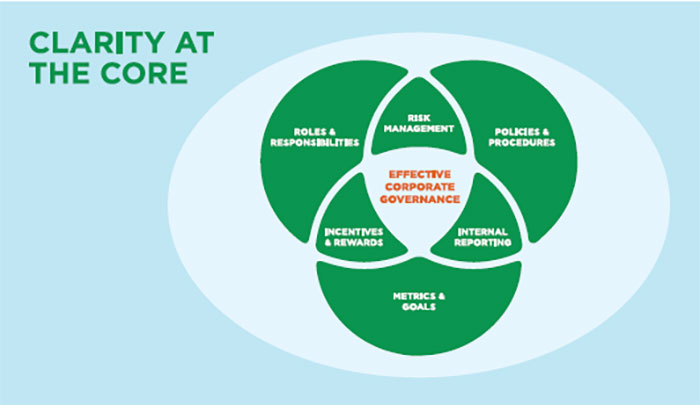Firm Governance Best Practices
by Daniel J. McMahon, CPA, CM&AA, Integrated Growth Advisors –
July 9, 2024

“You simply cannot drive forward if you’re focused on what’s happening in the rearview mirror.” ~ Steve Harvey, American television host and film producer
Successful organizations thrive when their mission, vision and values are embraced at all levels. Like great sports teams, professional services firms that have a clear vision and purpose are best positioned to sustain their excellence year after year. These teams and firms can benefit from clarity at the core. Clarity at the core encompasses three elements that must be clearly understood at all levels of the team and organization: policies and procedures; roles and responsibilities; and metrics and goals.
Clients often ask what “good governance” might look like at their privately owned companies. Privately owned business owners can develop and implement sound governance practices at their discretion. It’s crucial to remind them that the most important thing for private companies to have is alignment and accountability around the three elements above from top to bottom in the organization.
Firm leaders have less bandwidth today than ever before. They are pulled in many directions, and that has a cascading impact on their managers and staff. Feeling overstretched and frazzled seems to be the norm in today s working environment. But when company leadership is focused on accountability and alignment, their bandwidth is freed up and their teams can then focus on activities that correspond to the highest and best use of their time and energy.
Having an effective governance structure in place allows firms to reduce stress and burnout throughout the organization. This, in turn, correlates to better staff retention, higher profitability and less risk.

Why Good Governance?
The most profitable firms find a way to enable their team members to perform at their pay grade. They accomplish this by maintaining alignment and accountability throughout their firms. So, how do you achieve alignment and accountability? Let’s take them one at a time.
- Policies and procedures. Since CPAs follow professional standards, accounting firms usually have very strong policies and procedures. Routing a tax return or audit through the office to obtain signoffs, for example, happens seamlessly in most cases. CPAs are also very good at following checklists and they subscribe to services that provide them with useful practice aids. CPA firms generally benefit from clarity around their strong policies and procedures.
- Roles and responsibilities. Roles and responsibilities are critically important, especially at growing firms in which people wear many hats. We have all seen what happens when the org chart is disregarded and the fire drill takes over. Having clarity about each person s roles and responsibilities protects a firm from burnout and from the fatigue associated with the constant cycle of recruiting, hiring and training. Alignment comes from assigning organizational responsibilities to each person that are commensurate with the highest and best use of their talents. Doing so creates value for clients at each step of the service delivery process.
- Metrics and goals. There is an old cliche: “What gets measured gets done.” And, while roles and responsibilities are all about alignment, metrics and goals are all about accountability. When you commit your goals to writing, there’s a much greater chance of achieving them. Metrics measure the progress or achievement of goals.
As CPAs, we spend a lot of time working on the past results of our clients. We need to match the same level of energy and focus to our present and to our future. A strong governance structure, with leadership driving clarity at the core, will get you headed in the right direction and ideally positioned to address any challenge that may arise in the future.
As Jack Welch liked to say, “Seeing around corners is an element of success. It’s what differentiates the good leader.”
 | Daniel McMahonDaniel J. McMahon, CPA, CMAA, is the founder and managing partner of Integrated Growth Advisors (IGA), LLC, a value creation and growth advisory firm. More content by Daniel McMahon: |
This article appeared in the Summer 2024 issue of New Jersey CPA magazine. Read the full issue.